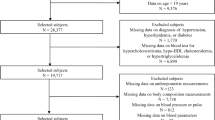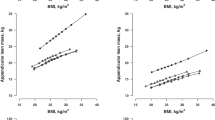Abstract
Objectives:
The aim of this study was to compare novel and established anthropometrical measures in their ability to predict cardiovascular disease (CVD), and to determine whether they improve risk prediction beyond classical risk factors in a cohort study of 60-year-old men and women. We also stratified the results according to gender to identify possible differences between men and women. Furthermore, we aimed to replicate our findings in a large independent cohort (The Malmö Diet and Cancer study—cardiovascular cohort).
Methods:
This was a population-based study of 1751 men and 1990 women, aged 60 years and without CVD at baseline, with 375 incident cases of CVD during 11 years of follow-up. Weight, height, waist circumference (WC), hip circumference and sagittal abdominal diameter (SAD) were measured at baseline. Body mass index (BMI), waist–hip ratio (WHR), waist–hip-height ratio (WHHR), WC-to-height ratio (WCHR) and SAD-to-height ratio (SADHR) were calculated.
Results:
All anthropometric measures predicted CVD in unadjusted Cox regression models per s.d. increment (hazard ratios, 95% confidence interval), while significant associations after adjustments for established risk CVD factors were noted for WHHR 1.20 (1.08–1.33), WHR 1.14 (1.02–1.28), SAD 1.13 (1.02–1.25) and SADHR 1.17 (1.06–1.28). WHHR had higher increases in C-statistics, and model improvements (likelihood ratio tests (P<0.001)). In the replication study (MDC-CC, n=5180), WHHR was the only measure that improved Cox regression models in men (P=0.01).
Conclusion:
WHHR, a new measure reflecting body fat distribution, showed the highest risk estimates after adjustments for established CVD risk factors. These findings were verified in men but not women in an independent cohort.
This is a preview of subscription content, access via your institution
Access options
Subscribe to this journal
Receive 12 print issues and online access
$259.00 per year
only $21.58 per issue
Buy this article
- Purchase on Springer Link
- Instant access to full article PDF
Prices may be subject to local taxes which are calculated during checkout
Similar content being viewed by others
References
Narayan KM, Ali MK, Koplan JP . Global noncommunicable diseases-where worlds meet. N Engl J Med 2010; 363: 1196–1198.
Wandell PE, Carlsson AC, Theobald H . The association between BMI value and long-term mortality. Int J Obes (Lond) 2009; 33: 577–582.
Lapidus L, Bengtsson C, Larsson B, Pennert K, Rybo E, Sjostrom L . Distribution of adipose tissue and risk of cardiovascular disease and death: a 12 year follow up of participants in the population study of women in Gothenburg, Sweden. Br Med J (Clin Res Ed) 1984; 289: 1257–1261.
Larsson B, Svardsudd K, Welin L, Wilhelmsen L, Bjorntorp P, Tibblin G . Abdominal adipose tissue distribution, obesity, and risk of cardiovascular disease and death: 13 year follow up of participants in the study of men born in 1913. Br Med J (Clin Res Ed) 1984; 288: 1401–1404.
Yusuf S, Hawken S, Ounpuu S, Bautista L, Franzosi MG, Commerford P et al. Obesity and the risk of myocardial infarction in 27,000 participants from 52 countries: a case-control study. Lancet 2005; 366: 1640–1649.
Pischon T, Boeing H, Hoffmann K, Bergmann M, Schulze MB, Overvad K et al. General and abdominal adiposity and risk of death in Europe. N Engl J Med 2008; 359: 2105–2120.
Wormser D, Kaptoge S, Di Angelantonio E, Wood AM, Pennells L, Thompson A et al. Separate and combined associations of body-mass index and abdominal adiposity with cardiovascular disease: collaborative analysis of 58 prospective studies. Lancet 2011; 377: 1085–1095.
Riserus U, de Faire U, Berglund L, Hellenius ML . Sagittal abdominal diameter as a screening tool in clinical research: cutoffs for cardiometabolic risk. J Obes 2010; 2010: 757939.
Rosenblad A, Leppert J, Nilsson G . The waist-hip-height-ratio (WHHR): An improvement of the waist-hip-ratio for predicting all-cause mortality. J Diabetes 2011; 3: 1753.
Hadaegh F, Zabetian A, Harati H, Azizi F . Waist/height ratio as a better predictor of type 2 diabetes compared to body mass index in Tehranian adult men—a 3.6-year prospective study. Exp Clin Endocrinol Diabetes 2006; 114: 310–315.
Petursson H, Sigurdsson JA, Bengtsson C, Nilsen TI, Getz L . Body configuration as a predictor of mortality: comparison of five anthropometric measures in a 12 year follow-up of the Norwegian HUNT 2 study. PLoS One 2011; 6: e26621.
Wandell PE, Carlsson AC, de Faire U, Hellenius ML . Prevalence of blood lipid disturbances in Swedish and foreign-born 60-year-old men and women in Stockholm, Sweden. Nutr Metab Cardiovasc Dis 2011; 21: 173–181.
Carlsson AC, Wandell PE, de Faire U, Hellenius ML . Risk factors associated with newly diagnosed high blood pressure in men and women. Am J Hypertens 2008; 21: 771–777.
Carlsson AC, Wandell PE, Halldin M, de Faire U, Hellenius ML . Is a unified definition of metabolic syndrome needed? Comparison of three definitions of metabolic syndrome in 60-year-old men and women. Metab Syndr Relat Disord 2009; 7: 231–241.
Carlsson AC, Wandell PE, Journath G, de Faire U, Hellenius ML . Factors associated with uncontrolled hypertension and cardiovascular risk in hypertensive 60-year-old men and women—a population-based study. Hypertens Res 2009; 32: 780–785.
Nordhamn K, Sodergren E, Olsson E, Karlstrom B, Vessby B, Berglund L . Reliability of anthropometric measurements in overweight and lean subjects: consequences for correlations between anthropometric and other variables. Int J Obes Relat Metab Disord 2000; 24: 652–657.
Hedblad B, Nilsson P, Janzon L, Berglund G . Relation between insulin resistance and carotid intima-media thickness and stenosis in non-diabetic subjects. Results from a cross-sectional study in Malmo, Sweden. Diabet Med 2000; 17: 299–307.
Li C, Engstrom G, Hedblad B, Calling S, Berglund G, Janzon L . Sex differences in the relationships between BMI, WHR and incidence of cardiovascular disease: a population-based cohort study. Int J Obes (Lond) 2006; 30: 1775–1781.
Melander O, Newton-Cheh C, Almgren P, Hedblad B, Berglund G, Engstrom G et al. Novel and conventional biomarkers for prediction of incident cardiovascular events in the community. JAMA 2009; 302: 49–57.
Harrell FE Jr, Lee KL, Mark DB . Multivariable prognostic models: issues in developing models, evaluating assumptions and adequacy, and measuring and reducing errors. Stat Med 1996; 15: 361–387.
Kerr KF, McClelland RL, Brown ER, Lumley T . Evaluating the incremental value of new biomarkers with integrated discrimination improvement. Am J Epidemiol 2011; 174: 364–374.
Tzoulaki I, Liberopoulos G, Ioannidis JP . Use of reclassification for assessment of improved prediction: an empirical evaluation. Int J Epidemiol 2011; 40: 1094–1105.
Sundstrom J, Byberg L, Gedeborg R, Michaelsson K, Berglund L . Useful tests of usefulness of new risk factors: tools for assessing reclassification and discrimination. Scand J Public Health 2011; 39: 439–441.
Conroy RM, Pyorala K, Fitzgerald AP, Sans S, Menotti A, De Backer G et al. Estimation of ten-year risk of fatal cardiovascular disease in Europe: the SCORE project. Eur Heart J 2003; 24: 987–1003.
Iribarren C, Darbinian JA, Lo JC, Fireman BH, Go AS . Value of the sagittal abdominal diameter in coronary heart disease risk assessment: cohort study in a large, multiethnic population. Am J Epidemiol 2006; 164: 1150–1159.
Mukuddem-Petersen J, Snijder MB, van Dam RM, Dekker JM, Bouter LM, Stehouwer CD et al. Sagittal abdominal diameter: no advantage compared with other anthropometric measures as a correlate of components of the metabolic syndrome in elderly from the Hoorn Study. Am J Clin Nutr 2006; 84: 995–1002.
Bjorntorp P, Holm G, Rosmond R . Hypothalamic arousal, insulin resistance and Type 2 diabetes mellitus. Diabet Med 1999; 16: 373–383.
Rutters F, Nieuwenhuizen AG, Lemmens SG, Bouwman F, Mariman E, Westerterp-Plantenga MS . Associations between anthropometrical measurements, body composition, single-nucleotide polymorphisms of the hypothalamus/pituitary/adrenal (HPA) axis and HPA axis functioning. Clin Endocrinol (Oxf) 2011; 74: 679–686.
Cesari M, Penninx BW, Newman AB, Kritchevsky SB, Nicklas BJ, Sutton-Tyrrell K et al. Inflammatory markers and onset of cardiovascular events: results from the Health ABC study. Circulation 2003; 108: 2317–2322.
Heid IM, Jackson AU, Randall JC, Winkler TW, Qi L, Steinthorsdottir V et al. Meta-analysis identifies 13 new loci associated with waist-hip ratio and reveals sexual dimorphism in the genetic basis of fat distribution. Nat Genet 2010; 42: 949–960.
Berg C, Rosengren A, Aires N, Lappas G, Toren K, Thelle D et al. Trends in overweight and obesity from 1985 to 2002 in Goteborg, West Sweden. Int J Obes (Lond) 2005; 29: 916–924.
Rosengren A, Eriksson H, Hansson PO, Svardsudd K, Wilhelmsen L, Johansson S et al. Obesity and trends in cardiovascular risk factors over 40 years in Swedish men aged 50. J Intern Med 2009; 266: 268–276.
Rosengren A, Eriksson H, Larsson B, Svardsudd K, Tibblin G, Welin L et al. Secular changes in cardiovascular risk factors over 30 years in Swedish men aged 50: the study of men born in 1913, 1923, 1933 and 1943. J Intern Med 2000; 247: 111–118.
James WP, Caterson ID, Coutinho W, Finer N, Van Gaal LF, Maggioni AP et al. Effect of sibutramine on cardiovascular outcomes in overweight and obese subjects. N Engl J Med 2010; 363: 905–917.
Dormandy JA, Charbonnel B, Eckland DJ, Erdmann E, Massi-Benedetti M, Moules IK et al. Secondary prevention of macrovascular events in patients with type 2 diabetes in the PROactive Study (PROspective pioglitAzone Clinical Trial In macroVascular Events): a randomised controlled trial. Lancet 2005; 366: 1279–1289.
Carlsson AC, Theobald H, Hellenius ML, Wandell PE . Cardiovascular and total mortality in men and women with different blood pressure levels—A 26-year follow-up. Blood Press 2009; 18: 105–110.
Journath G, Hellenius ML, Carlsson AC, Wandell PE, Nilsson PM . Physicians' gender is associated with risk factor control in patients on antihypertensive and lipid lowering treatment. Blood Press 2010; 19: 240–248.
Almgren T, Wilhelmsen L, Samuelsson O, Himmelmann A, Rosengren A, Andersson OK . Diabetes in treated hypertension is common and carries a high cardiovascular risk: results from a 28-year follow-up. J Hypertens 2007; 25: 1311–1317.
Acknowledgements
This study was supported by grants from the Stockholm County Council, Karolinska Institutet, the Swedish Heart and Lung Foundation, the Swedish Council for Working Life and Social Research, the Swedish Research Council (Longitudinal Research and K2005-27X-14278-04A), The Cardiovascular Program at Karolinska Institutet and the Strategic Support for Epidemiological Research at Karolinska Institutet.
Disclaimer
The study was investigator initiated and driven.
Author information
Authors and Affiliations
Corresponding author
Ethics declarations
Competing interests
The authors declare no conflict of interest.
Rights and permissions
About this article
Cite this article
Carlsson, A., Risérus, U., Engström, G. et al. Novel and established anthropometric measures and the prediction of incident cardiovascular disease: a cohort study. Int J Obes 37, 1579–1585 (2013). https://doi.org/10.1038/ijo.2013.46
Received:
Revised:
Accepted:
Published:
Issue Date:
DOI: https://doi.org/10.1038/ijo.2013.46
Keywords
This article is cited by
-
Identification of the Best Anthropometric Index for Predicting the 10-Year Cardiovascular Disease in Southwest China: A Large Single-Center, Cross-Sectional Study
High Blood Pressure & Cardiovascular Prevention (2022)
-
Comparison of the associations between non-traditional and traditional indices of adiposity and cardiovascular mortality: an observational study of one million person-years of follow-up
International Journal of Obesity (2019)
-
Comparison of various surrogate obesity indicators as predictors of cardiovascular mortality in four European populations
European Journal of Clinical Nutrition (2013)



